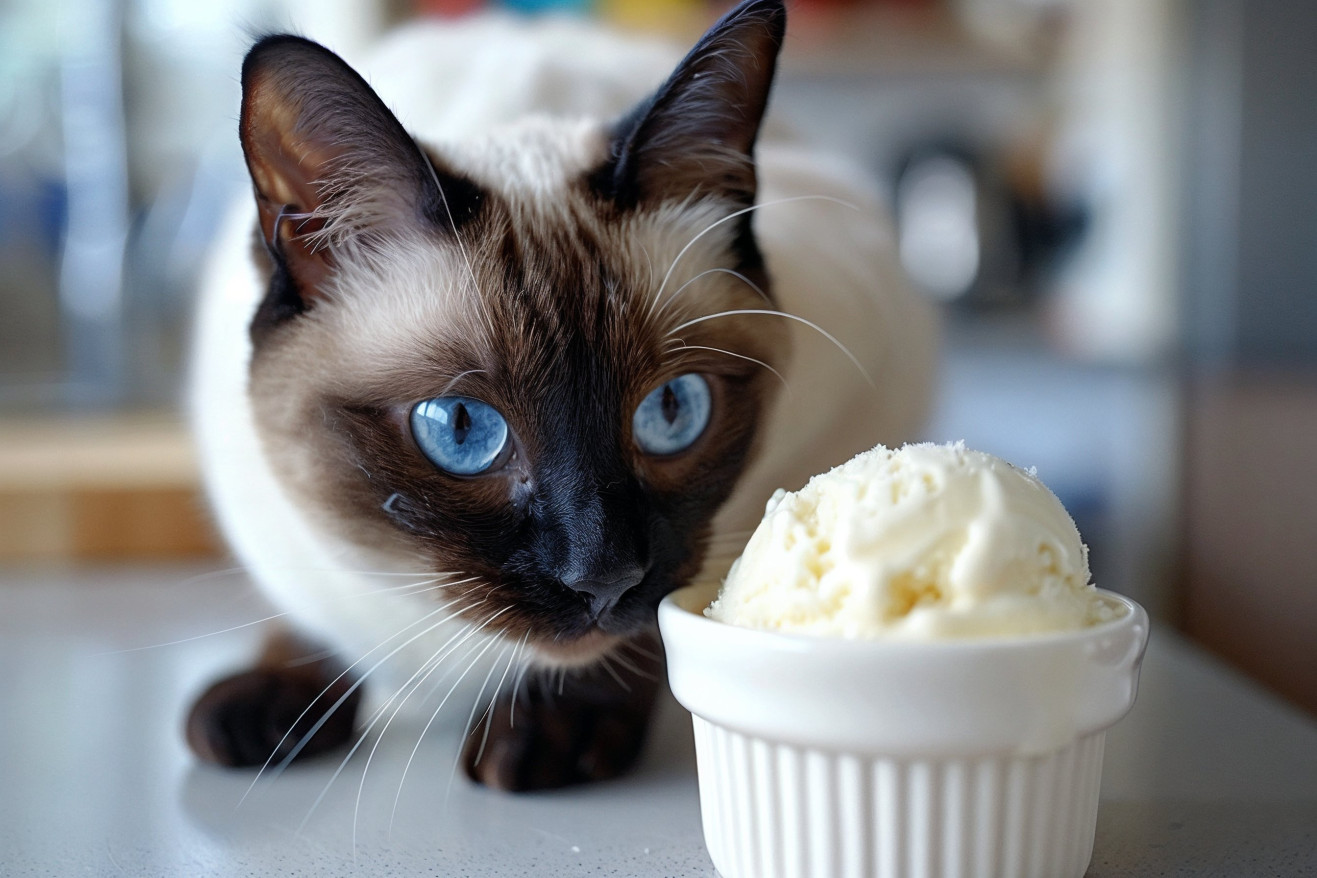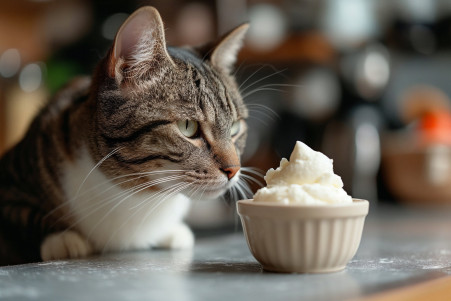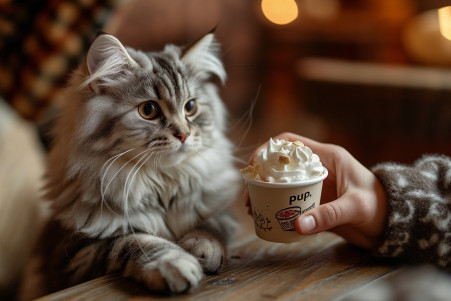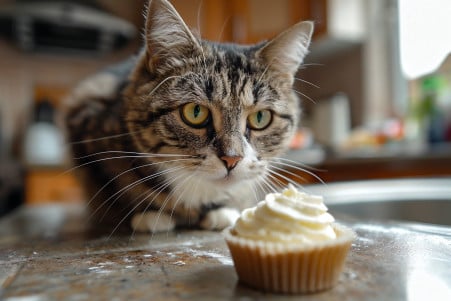Can Cats Eat Ice Cream? Know the Risks and Alternatives
23 February 2024 • Updated 22 February 2024

If you have a cat, you’ve probably noticed them staring at your ice cream, but is it safe to give them a taste? Unfortunately, we don’t recommend feeding cats ice cream because it can be high in sugar and other harmful ingredients, and cats are lactose intolerant. Instead, you can give them cat-safe treats or a lactose-free option in moderation.
This article will use information from veterinarians and nutritional data to explain why ice cream is bad for cats. We’ll look at studies on how animals digest certain ingredients, including lactose in cats, and the effects of sugar and high-calorie foods on cats. With this information, we’ll explain why ice cream is bad for cats and offer some alternative treats that are better for them.
Can cats eat ice cream?
How Lactose Intolerance Works in Cats
Lactose intolerance in cats is the result of a lack of lactase, the enzyme that breaks down lactose, the sugar found in dairy products, in the adult feline digestive system. According to Zoetis Petcare, most adult cats are lactose intolerant because they stop producing enough lactase after weaning.
When lactose intolerant cats eat dairy products like ice cream, the lactose in the product ferments in their gut instead of being properly digested, leading to symptoms like gas, cramps, diarrhea, and vomiting.
Linda P. Case, a veterinary nutritionist at the University of Illinois College of Veterinary Medicine, says that cats’ natural lactase production decreases as they get older, so even a small amount of ice cream can lead to gastrointestinal distress in cats within 8 to 12 hours.
Pet parents can avoid this by choosing other treats, like lactose-free milk made for cats or cultured dairy products like plain yogurt, which have less lactose because it’s been fermented.
However, even these options should be given in moderation to avoid other health problems, and it’s important to remember that water is the most important and safest liquid for cats.
Sugar and Caloric Impact on Cat Health
The Cats Protection Blog explains that cats are obligate carnivores and, therefore, have no need for sugar in their diet, a fact that is supported by the lack of sweet taste receptors in their mouths.
As a result, sugar and calorie-rich diets, like those found in ice cream, can have serious consequences. A study in PMC shows that sugar consumption can lead to obesity in cats, which is one of the most common nutritional disorders in cats and greatly increases the risk of diabetes.
Meanwhile, PetMD points out that there is a clear link between diet and the development of hyperglycemia, or high blood sugar, in cats. It explains that overeating and high-calorie diets are the most common causes of diabetes mellitus, which can have a serious impact on a cat’s life and requires ongoing care.
As a result, it’s important for cat owners to pay attention to the treats they give their pets, making sure they are high in protein and low in carbohydrates to meet their cat’s nutritional needs as obligate carnivores. This way, pet owners can make sure that their cats are getting a balanced diet, with treats making up only a small part of their overall nutrition, and that they can live a long, healthy life without the risks that come with sugar-rich treats like ice cream.
Healthy Treats for Your Cat
When you give your cat a treat, you’re not just showing them love; you’re also making sure they get the nutrients they need.
Because cats are obligate carnivores, they require a diet that’s high in animal protein and that has specific nutrient ratios, according to PetMD.
That’s why options like cooked, unseasoned poultry, such as chicken or turkey, are good choices. They offer high-quality protein and important vitamins and minerals like vitamin B6 and selenium. Cooked beef and fish can also be good choices because they contain omega-3 fatty acids, which are good for the skin and coat.
If you want to give your cat a commercial treat, options like Wellness Kittles are a great choice. Not only will they make your cat’s taste buds happy, but they also offer important nutrients thanks to their natural, grain-free ingredients, according to The Spruce Pets.
Plus, with just 1.1 calories per treat, it’s easy to make sure your cat doesn’t overdo it. No matter what kind of treat you’re giving your cat, make sure that the first ingredient is meat and that there are no artificial additives.
No matter what kind of treat you’re giving your cat, make sure to introduce it slowly and watch your cat for any signs of a bad reaction. It’s also a good idea to stick to bland treats and avoid ingredients that are toxic to cats, like onions and garlic, according to Sploot Veterinary Care.
By being careful about the treats you choose and keeping an eye on how much your cat eats, you can make sure that they have a well-rounded diet that will help them stay healthy and happy for years to come.
Improving Cat Behavior with Treats
Treats are an important part of a cat’s life for reasons that go beyond just being a special snack. They are also a critical part of training and can help cats overcome phobias through a process called classical counterconditioning.
When a treat is given to a cat in a stressful situation, Feline Engineering explains that the cat will create a positive association, which will eventually override the negative feelings associated with the situation. This is because the cat will learn to associate the situation with the treat, and therefore, with a positive experience.
However, it is important to be careful with the amount of treats that are given to cats in these situations to ensure that the process is successful.
In addition to the potential for helping cats overcome phobias, treats can also be detrimental to cats’ mental health. According to PawTracks, cats can become addicted to treats, and this can be seen in their behavior.
Signs of addiction can include cats begging for treats constantly and becoming irritable when they are not given treats. To help prevent this, owners should give cats low-calorie or natural treats and use them as a reward for specific behaviors rather than as a treat that is given for no reason.
To help ensure that cats are getting the right amount of treats and regular food, owners should follow a feeding schedule. According to PMC, owners should try to mimic natural feeding patterns by feeding cats smaller, more frequent meals and using treat-dispensing toys with regular food to help prevent overeating. By doing this, owners can help ensure that their cats’ mental health is supported while also ensuring that their physical health is not compromised.
Final Thoughts: Can Cats Eat Ice Cream?
In this article, we’ve gone over the reasons why it’s best to avoid sharing ice cream with your cat. We’ve looked at the ingredients in ice cream and why they are not good for cats, including dairy, sugar, and some common flavorings.
With the high rate of lactose intolerance in adult cats and the lack of a dietary requirement for sugar, it’s clear that ice cream is not only nutritionally inappropriate for cats but can also be dangerous to their health.
By focusing on healthier, more appropriate treat options, we can make sure we’re honoring our cats’ obligate carnivore status and providing them with treats that will benefit them rather than harm them. By understanding that treats can be a useful part of training and behavior modification when used in moderation and with care, we can help support our cats’ health.
It’s important for us to make sure we’re putting our cats’ health and well-being first as their caretakers. By making choices that take their nutritional needs into account, we can make sure we’re doing our best to support our feline friends’ health and well-being. And don’t forget, when it comes to treats, it’s always best to keep it simple, keep it safe, and keep it species-appropriate.


